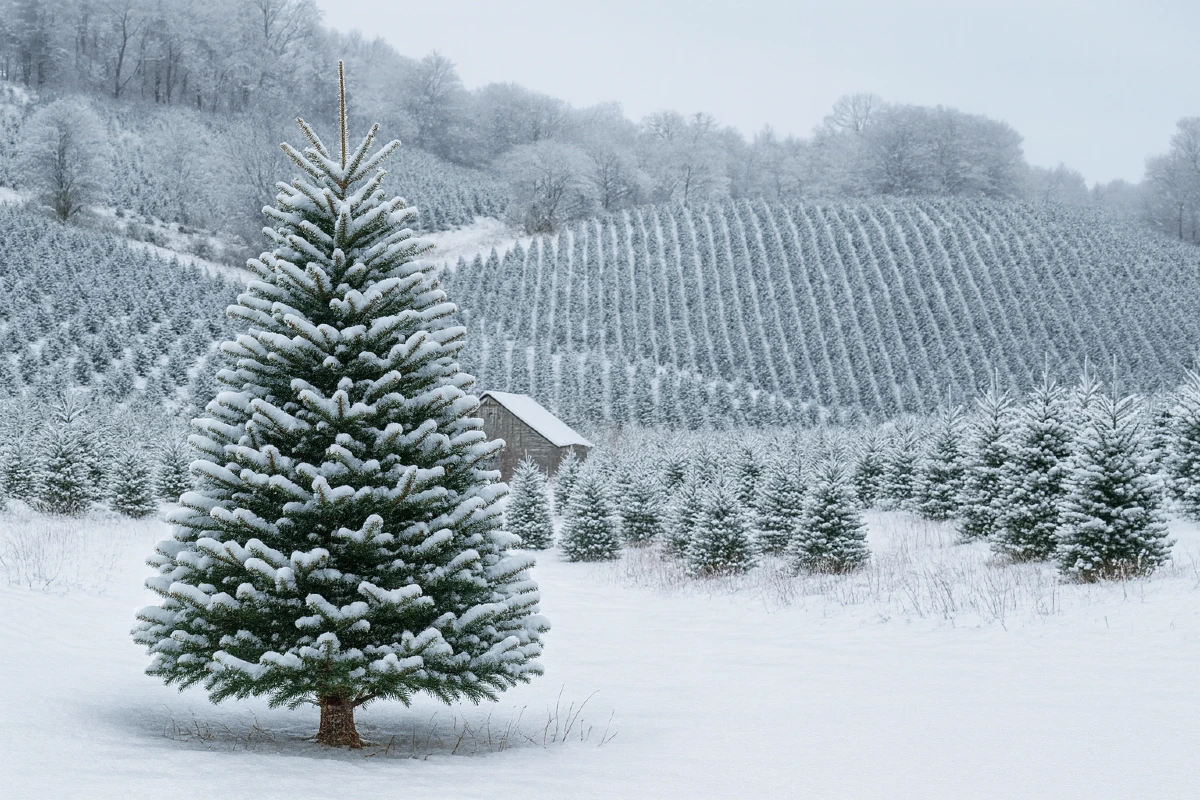Fraser Fir Christmas Tree Guide

Is the Fraser Fir a Good Christmas Tree?
If you’re looking for the best Christmas tree, our Best Christmas Tree guide is a great place to start. But if your holiday tradition includes bundling up for a U-cut adventure on the farm — or finding that perfect pre-cut tree to bring home — the Fraser Fir Christmas Tree is hard to beat.
Imagine walking down the rows: each Fraser Fir stands like it’s been shaped for a Christmas card, branches angled just right for ornaments, needles glistening with a silvery underside when they catch the winter light. Bend a branch and you’ll catch its fresh, woodsy scent — the smell most people call simply “Christmas.”
That’s why families drive out of their way for Fraser Firs. They’re beautiful, sturdy, long-lasting, and fill the whole season with cheer. No wonder it’s the tree of choice not just for homes across North America, but even for the White House.
Pros:
- Excellent needle retention indoors (stays fresh longer)
- Classic conical shape with strong branches for ornaments
- Pleasant evergreen fragrance
- Silvery underside of needles creates a beautiful two-tone effect
Cons:
- Takes 7–10 years to reach market height
- Tends to be more expense.
- Limited availabilities
Description & Common Characteristics of the Fraser Fir
When you imagine the “perfect Christmas tree,” chances are you’re picturing a Fraser Fir. Its dark green needles with silvery undersides create a shimmering two-tone effect that looks magical under string lights. Each branch angles slightly upward, giving the tree its signature compact, conical silhouette — the kind decorators dream of because it’s strong enough to hold ornaments yet elegant enough to stand beautifully on its own.
But the Fraser Fir’s story is more than just looks. This tree carries history in its branches. It’s named after John Fraser, a Scottish botanist who explored the Appalachian Mountains in the 1700s and helped introduce the tree to science. Today, Fraser Fir is so iconic it’s been chosen for the White House Christmas tree more than any other species. In North Carolina — the heart of Fraser Fir country — it was even declared the state’s official Christmas tree in 2005.
What makes it so enduringly popular? Shoppers rave about three things:
- Needle retention: Even weeks after cutting, Fraser Firs hold their soft, flexible needles longer than most trees.
- Fragrance: Its crisp, resinous scent is the classic “Christmas smell” — fresh, woodsy, and inviting.
- Color & form: The glossy green needles and naturally symmetrical shape need little trimming, making every tree look like it was grown for a holiday card.
The Fraser Fir hasn’t always been a farm staple. Back in the mid-1900s, families often cut wild Fraser Firs straight from the Appalachian forests. As demand grew, farmers began cultivating them in dedicated fields. By the 1960s, growers in western North Carolina realized they were onto something special — a tree that could outlast long holiday seasons, ship well across the country, and consistently delight families. Today, more than 99% of Christmas trees grown in North Carolina are Fraser Firs, and they’re shipped nationwide.
So when you bring home a Fraser Fir, you’re not just decorating with a tree. You’re part of a tradition that’s been generations in the making — from mountain forests to farm fields to your living room, carrying with it the look, scent, and spirit of Christmas itself.
Needle Retention & Fragrance
“How long will the needles last?” That’s the Fraser Fir’s specialty. Even after being cut, its needles cling tightly to branches, minimizing holiday clean-up. The fragrance is fresh, resinous, and distinctly festive — the scent many people imagine when they think of Christmas morning.
Where Do Fraser Fir Christmas Trees Grow?
In the wild, Fraser Firs are native only to the southern Appalachian Mountains — at high elevations in western North Carolina, eastern Tennessee, and southwestern Virginia. There, they thrive in cool, moist climates with cloud cover and acidic soils.
On farms, Fraser Firs are cultivated far beyond their natural range. They grow successfully in northern U.S. states and in Canadian provinces like Québec, where the climate mimics their native environment. North Carolina remains the hub of commercial production, with over 40,000 acres dedicated to Fraser Fir farms — accounting for more than 99% of the state’s Christmas tree crop.
How Much Does a Fraser Fir Christmas Tree Cost?
Pricing varies by region and by whether you choose a pre-cut tree at a lot or a cut-your-own experience at a farm and often ranges from about $15–$30 per foot depending on size and region.
- Small (4–5 ft): $45–$75
- Medium (6–7 ft): $75–$120 (most popular size)
- Large (8–10 ft): $120–$200+ depending on supply and region
In urban centers, expect to pay at the higher end due to transport costs. Visiting a local farm often gives you fresher trees at more competitive prices — plus the holiday fun of picking your own.
How to Care for a Fraser Fir Christmas Tree
Want your Fraser Fir to look beautiful all season? Follow this checklist:
- Fresh cut: Before placing in the stand, saw off ½ inch from the base to open water channels.
- Keep water topped up: The stand should never run dry; check daily.
- Choose the right spot: Place away from heating vents, fireplaces, or direct sunlight.
- Vacuum gently: If a few needles drop, a quick sweep keeps things tidy.
- Secure stand: Fraser Firs have straight trunks that fit stands easily, but always double-check stability.
With good care, a Fraser Fir can last 4–6 weeks indoors without major needle loss.
Where to Find a Fraser Fir Christmas Tree Near You
Ready to bring one home? Use our Christmas tree farms directory to find local growers offering Fraser Fir Christmas Trees. Whether you want a pre-cut tree in the city or a choose-and-cut adventure in the countryside, our directory makes it simple to find fresh, farm-grown options near you.